Violent imagery is often seen in Medieval manuscripts and can serve as decoration or illustrations related to the text. Decorative imagery is primarily displayed around the border of the parchment and imagery that furthers the written material is usually displayed in between paragraphs or on an adjacent page. Images of violence were seen as a necessary part of life to teach various lessons on morals and societal guidelines. Wars, barbaric tournaments, and battles for power made violence a common occurrence. This imagery can provide individuals with a glimpse into their lifestyle and social norms. These images can be explored from around the world with the help of the internet.
The growth of the internet continues to push the accessibility and spread of information to new levels. This allows individuals to become aware of, both positive and negative, events occurring around the world. Medieval manuscripts experience a wave of distribution in the form of a meme and are interpreted in a completely different context. The Medieval manuscripts in this exhibit were created between c 1235 – c 1360.
This exhibit investigates the revival and recontextualization of violent Medieval manuscript imagery in the form of memes and image macros by adding text to the preexisting images. The events depicted in these Medieval manuscripts were seen as typical and relatable by those alive at the time. Memes are able to change the context of Medieval imagery to a situation that present-day people can relate to by simply adding text. Memes that utilize medieval imagery allow people to compare and contrast between the two time periods.
Psalter, ca 1235-1250
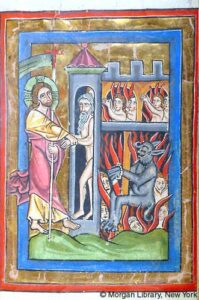
This image is titled “Christ: Harrowing of Hell” and depicts Jesus Christ holding a bannered cross-staff in his left hand and the wrist of a naked man in his right hand. The background of the image is painted gold. The naked man that Jesus is grabbing and another naked figure behind the naked man are possibly Adam and Eve. The two naked individuals are standing at the portals to the city gate of hell. The wall connected to the gate opens to depict the devil tied to a pillar and engulfed in flames with nude sinners. This could also represent Christ forgiving Adam and Eve for their sins but leaving their descendants to continue suffering in fiery depths of hell.
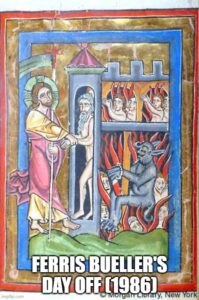
This meme follows the format of mislabeling images as a still of a movie because of minimal similarities between the image and a still of the movie. Some of the earliest examples of this format occurred on Tumblr in 2011. The main gag of this joke is that there is nothing genuinely new in the pop culture world. In the movie, Ferris Bueller’s Day Off, Bueller does everything he can to get himself and his friends out of school by pretending to be sick. They pull it off but they leave a great deal of chaos in their wake. It can be argued that Adam and Eve are responsible for the chaos and suffering that their descendants’ experience just like Bueller and his friends are somewhat responsible for the trouble they cause.
The Legend of the Saints by Jacques De Voragine, 1261-1266
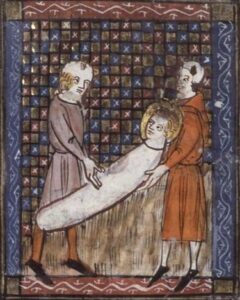
This portion of The Legend of Saints’ manuscript displays Saint Vitalis of Milan being buried alive. The Legend of the Saints by Jacques De Voragine details the lives of numerous saints. The exact date of his martyrdom and the individuals responsible for his death have not been confirmed but it is known that it occurred in Ravenna, a city located in modern-day Northern Italy. According to the Golden Legend, Vitalis was tortured and buried alive after he told Saint Ursicinus of Ravenna to stand strong under torture and was discovered to be a Christian. Before being buried alive, Vitalis was tortured on the rack. This practice stretches the body by attaching the individual to a wooden frame and pulling ropes attached to their wrists and ankles in opposite directions. This caused immense pain and would lead to their joints dislocating and eventually separating their limbs from their torso that was attached to the frame. Saint Vitalis was a notable military figure and a noble. Saint Valeria, the wife of Vitalis, was also martyred for a separate offense.
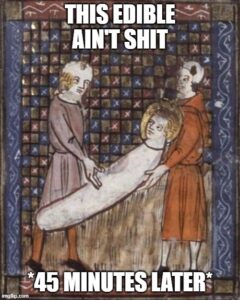
The added text to this preexisting image creates a meme about the delayed onset of effects from drugs that are ingested This refers to a joke from Twitter that means the individual does not feel high after ingesting edible marijuana. The image associated with the text often depicts the individual experiencing an intense high after a given amount of time when the effects of the edible kick in. This joke format became popular from a tweet in November of 2016 that was the first instance of the joke format.
Decretals of Gregory IX with glossa ordinaria (the ‘Smithfield Decretals’), Raymund of Peñafort, c 1300 – c 1340

In this image, a human-sized rabbit is wearing a red belt and stabbing a long sword through the neck of a kneeling man. Rabbits are not an uncommon theme in the margins of Medieval manuscripts, but their actions in illustrations are often unusual. In Medieval manuscripts, rabbits often display violent tendencies and human characteristics, such as the ability to wield weapons and using them against humans and other animals. Some scholars believe these rabbits to represent soldiers that are weak because hares are a symbol of cowardice. Scholars debate whether its purpose was entertainment or some kind of subversive message.

This meme references the recent adoption of the phrase “…these uncertain and unprecedented times” in emails as a response to the effects of the Covid-19 pandemic. This phrasing has quickly become overused to the point of losing all significant value and perceived as irritating. People would normally not get annoyed by this phrase but after repeatedly receiving emails with the phrase, it has become another source of irritation. Hares are typically docile and skittish animals. This meme creates the message that even a cowardly animal, such as the hare, would resort to violence after reading another email with this phrasing.
Codex Manesse, c 1304 – c 1340

This image comes from the Codex Manesse and contained poetry and songs. It is believed that the man being stabbed to death by four men with swords is Reinmar II von Brennberg. There were four people in the family with the name Reinmar von Brennberg and it was unclear which of the four was the poet. Reinmar II was not murdered in real life, but Reinmar III was. The Codex Manesse was a collection of work compiled from a long list of poets and their poems would be organized based on the nobility of their authors. It is unclear why this illustration was picked to represent Reinmar but his status as a ministerialis, an unfree noble elevated from the peasant class, could have been a factor.
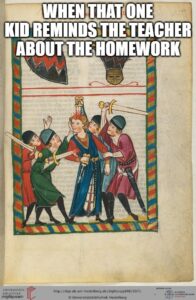
This meme portrays Reinmar as the annoying classmate who reminds the teacher to assign homework and desires to become the teacher’s favorite student. This causes the rest of the class to resent their classmate and show their disapproval. Their drastic response by stabbing him in the head and the chest mirrors the resentment a classmate would feel towards the teacher’s pet.
The Mirror of Human Salvation, Anonymous, c 1360

This image depicts King Eglon being assassinated by the Israelite judge Ehud and comes from the book, “The Mirror of Human Salvation”. Eglon was the king of Moab and oppressed the Israelites. Ehud tricked King Eglon by presenting him with a customary tribute and then stabbing Eglon in the chest with his sword. Eglon was supposedly so fat that Ehud was unable to remove the sword from his body after killing him. After the death of King Eglon became common knowledge, the Moabites fleed to other lands, and the Israelites celebrated 80 years of peace.
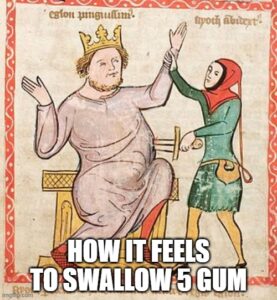
This meme is an adaptation of the “How It Feels to Chew 5 Gum” meme that mocks a series of advertisements for 5 Gum in 2007. The meme format was most popular during 2017. The original commercials showed euphoric, futuristic imagery. There are several myths about the dangers of swallowing gum and it staying in our bodies for seven years because the digestive system cannot break it down. The commercials were hyperbolic and associating the experience of swallowing 5 Gum with getting stabbed in the chest continues the exaggerated theme.
By Jason Lynn-Framm